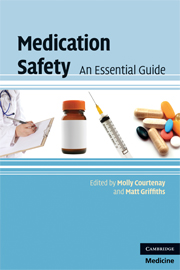Book contents
- Frontmatter
- Contents
- List of contributors
- Preface
- 1 Introduction to medication errors and medication safety
- 2 Safety in prescribing
- 3 Safety in dispensing
- 4 Safety in administering
- 5 Adverse drug reactions and drug interactions
- 6 Interface of care and communication
- 7 Parenteral drug administration
- 8 Calculations
- 9 Controlled drugs and patient safety
- 10 Reporting medication errors and near misses
- 11 Ensuring safety through evidence-based medicine
- Index
- References
10 - Reporting medication errors and near misses
Published online by Cambridge University Press: 22 January 2010
- Frontmatter
- Contents
- List of contributors
- Preface
- 1 Introduction to medication errors and medication safety
- 2 Safety in prescribing
- 3 Safety in dispensing
- 4 Safety in administering
- 5 Adverse drug reactions and drug interactions
- 6 Interface of care and communication
- 7 Parenteral drug administration
- 8 Calculations
- 9 Controlled drugs and patient safety
- 10 Reporting medication errors and near misses
- 11 Ensuring safety through evidence-based medicine
- Index
- References
Summary
Medication safety incidents
Introduction
Between January 2005 and June 2006 there were 59 802 medication safety incidents reported via the National Reporting and Learning System (NRLS) in England and Wales. Medication incidents are the second most commonly reported incident next to patient accidents (NPSA, 2007).
Although there has been an increase in reporting over the last 3 years, literature suggests gross inconsistencies and substantial under-reporting from a large number of NHS organizations (NPSA, 2007). This has been borne out in a systematic review of international literature from 12 countries suggesting the average rate of underreporting of adverse drug events is as high as 94% (Hazell & Shakir, 2006).
A significant proportion of low reporting or non-reporting has arisen from primary care organizations with only 4.9% of the total medication incidents reported to the NRLS coming from the primary care setting.
The aim of this chapter is to define what is meant by medication safety incidents and to examine where errors are likely to occur within the medication process, including a brief overview of some of the findings in the data that are pertinent to reporting medication incidents from the National Patient Safety Agency Report (2007) Safety in doses: medication safety incidents in the NHS. The main section in the chapter consists of guidance on how to report medication incidents, utilizing the recommendations from NPSA on how to improve reporting.
- Type
- Chapter
- Information
- Medication SafetyAn Essential Guide, pp. 155 - 172Publisher: Cambridge University PressPrint publication year: 2009
References
- 4
- Cited by



